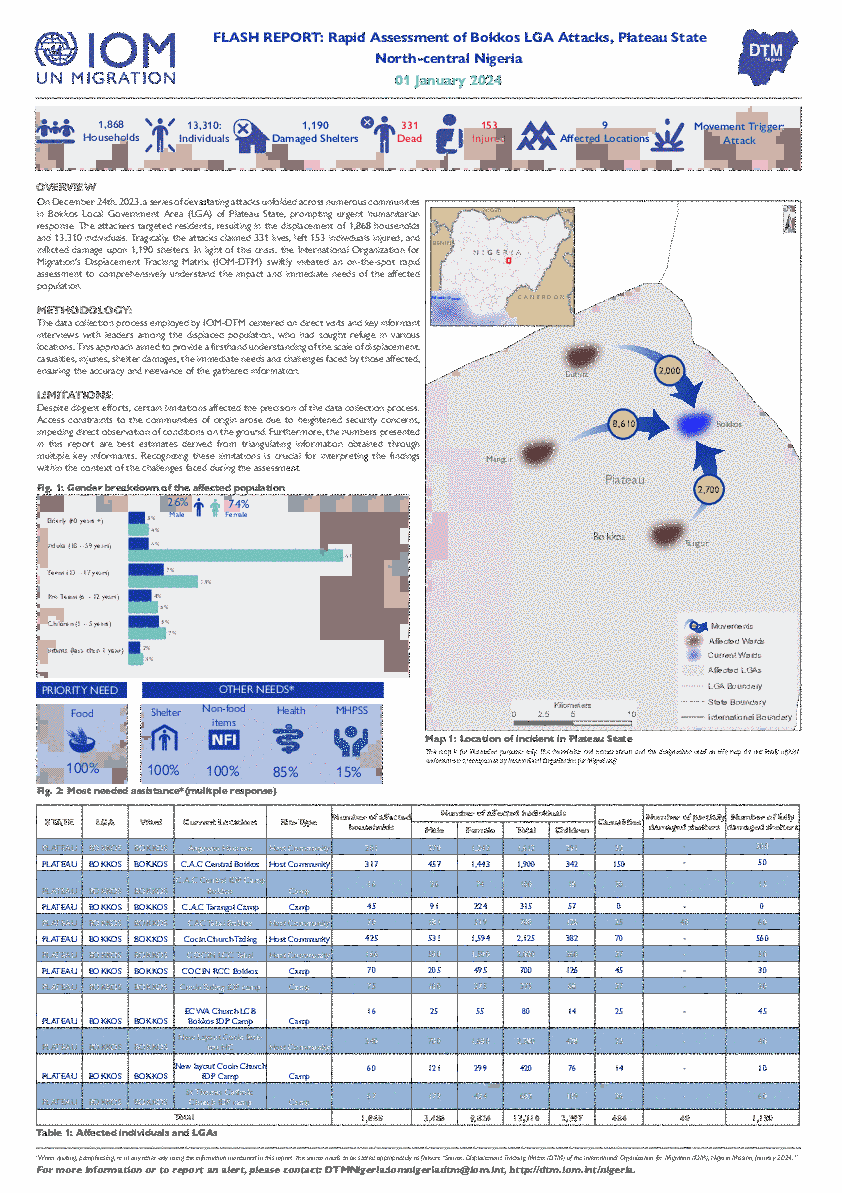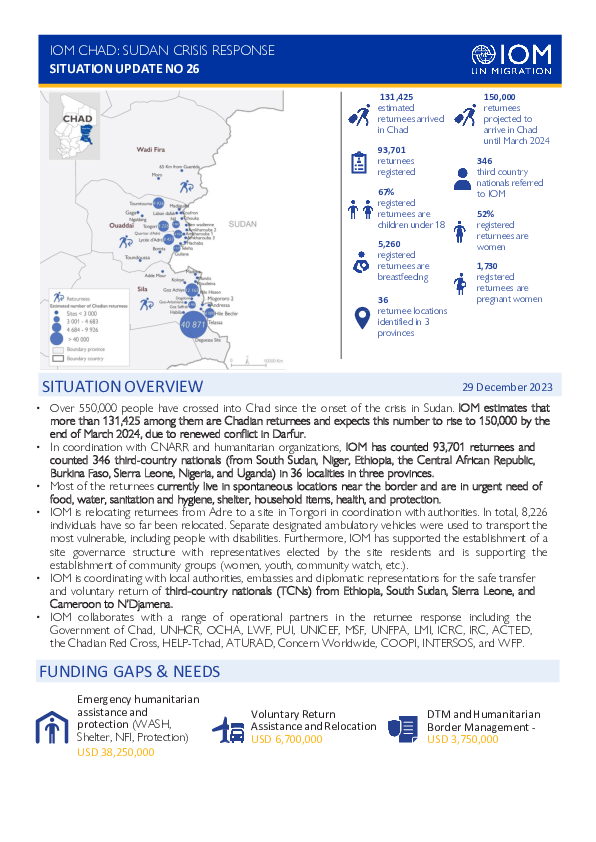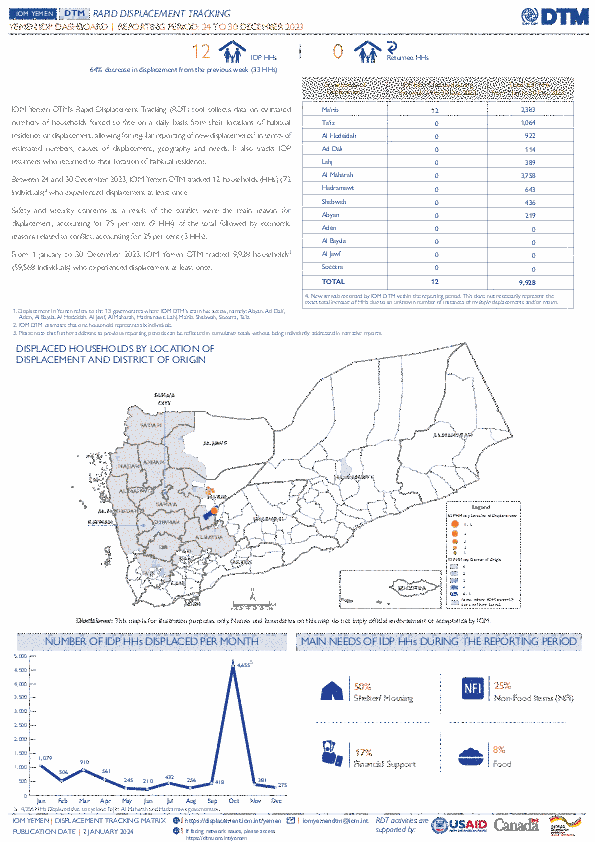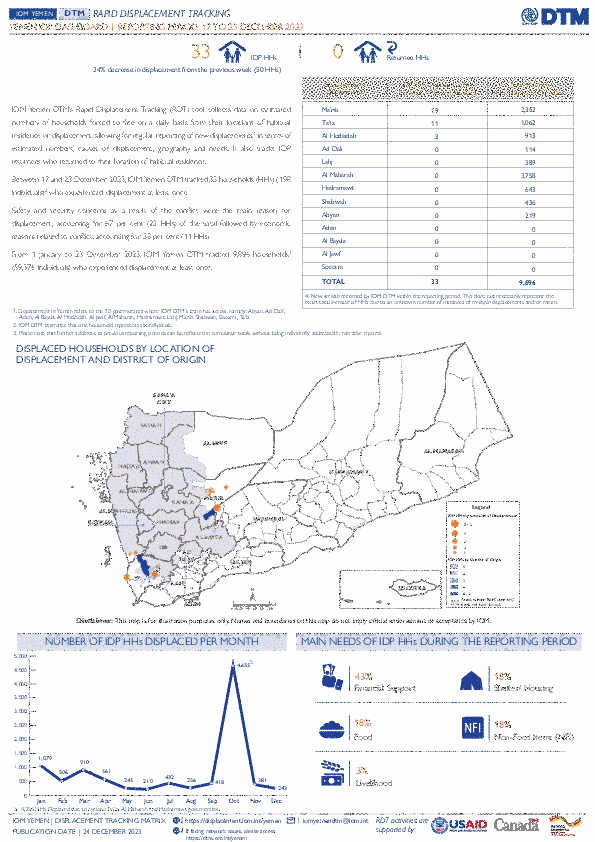-
Countries
-
Data and Analysis
-
Special Focus
-
Crisis Responses
Event Tracking

Contact
DTM Nigeria, iomnigeriadtm@iom.int
Language
English
Location
Nigeria
Snapshot Date
Dec 24 2023
Activity
- Mobility Tracking
- Event Tracking
On December 24th, 2023, a series of devastating attacks unfolded across numerous communities in Bokkos Local Government Area (LGA) of Plateau State, prompting urgent humanitarian response. The attackers targeted residents, resulting in the displacement of 1,868 households and 13,310 individuals. Tragically, the attacks claimed 331 lives, left 153 individuals injured, and inflicted damage upon 1,190 shelters. In light of this crisis, the International Organization for Migration’s Displacement Tracking Matrix (IOM-DTM) swiftly initiated an on-the-spot rapid assessment to comprehensively understand the impact and immediate needs of the affected population.

Contact
DTM Chad, dtmtchad@iom.int
Language
English
Location
Chad
Period Covered
Dec 29 2023
Dec 29 2023
Activity
- Mobility Tracking
- Event Tracking
• Over 550,000 people have crossed into Chad since the onset of the crisis in Sudan. IOM estimates that more than 131,425 among them are Chadian returnees and expects this number to rise to 150,000 by the end of March 2024, due to renewed conflict in Darfur.
• In coordination with CNARR and humanitarian organizations, IOM has counted 93,701 returnees and counted 346 third-country nationals (from South Sudan, Niger, Ethiopia, the Central African Republic, Burkina Faso, Sierra Leone, Nigeria, and Uganda) in 36 localities in three provinces.
• Most of the returnees currently live in spontaneous locations near the border and are in urgent need of food, water, sanitation and hygiene, shelter, household items, health, and protection.
• IOM is relocating returnees from Adre to a site in Tongori in coordination with authorities. In total, 8,226 individuals have so far been relocated. Separate designated ambulatory vehicles were used to transport the most vulnerable, including people with disabilities. Furthermore, IOM has supported the establishment of a site governance structure with representatives elected by the site residents and is supporting the establishment of community groups (women, youth, community watch, etc.).
• IOM is coordinating with local authorities, embassies and diplomatic representations for the safe transfer and voluntary return of third-country nationals (TCNs) from Ethiopia, South Sudan, Sierra Leone, and Cameroon to N’Djamena.
• IOM collaborates with a range of operational partners in the returnee response including the Government of Chad, UNHCR, OCHA, LWF, PUI, UNICEF, MSF, UNFPA, LMI, ICRC, IRC, ACTED, the Chadian Red Cross, HELP-Tchad, ATURAD, Concern Worldwide, COOPI, INTERSOS, and WFP.

Contact
DTM Somalia, IOMSomaliaDTM@iom.int
Language
English
Location
Somalia
Period Covered
Dec 10 2023
Dec 23 2023
Activity
- Mobility Tracking
- Event Tracking
In response to the Somalia’s severe drought beginning in November 2021, DTM Somalia launched an Emergency Trends Tracking (ETT) tool first in Gedo and Bay regions in 2022, and subsequently in Hiraan, Banadir and Middle Shabelle regions in 2023 to monitor drought related displacement trends and hotspots in support of operational planning. However, during the first half of 2023, conflict and flooding displacements have been significant. Therefore, DTM restructured its ETT tool to capture multi-shock displacements (drought, flood, conflict and other) from October 2023. In December 2023, ETT coverage has been expanded to Afgoyee district in Lower Shabelle region to cover the migration corridor between Afgooye and Mogadishu towns. As well as this, from week 49 onwards, ETT activities in Banadir have been paused.
ETT is a crisis-based tool that tracks sudden displacement triggered by specific events or emerging crises. The objective of ETT is to help prioritize humanitarian response and to enable partners to deliver rapid assistance.
Contact
DTM Yemen, iomyemendtm@iom.int
Location
Yemen
Activity
- Mobility Tracking
- Event Tracking
Period Covered
Dec 24 2023 -Dec 30 2023
From 1 January to 30 December 2023, IOM Yemen DTM tracked 9,928 households (HH) (59,568 Individuals) who experienced displacement at least once.
Between 24 and 30 December 2023, IOM Yemen DTM tracked 12 households (72 individuals) displaced at least once. The majority of people moved into/within the following governorates and districts:
- Ma’rib (21 HHs) – Marib (9 HHs), Marib City (7 HHs), Harib (5 HHs) districts. Most displacements in the governorate originated from Marib and Taiz.
- Al Hodeidah (9 HHs) – Al Khukhah (9 HHs) district. Most displacements in the governorate originated from Al Hodeidah and Taiz.
- Ta’iz (2 HHs) – Al Mudhaffar (2 HHs) district. All displacements in the governorate were internal.
The majority of people moved from the following governorates and districts:
- Ma’rib (10 HHs) – Harib (6 HHs), Raghwan (2 HHs), Bidbadah (1 HH) districts.
- Al Hodeidah (8 HHs) – At Tuhayta (7 HHs), Al Marawiah (1 HH) districts.
- Ta’iz (6 HHs) – Maqbanah (3 HHs), Salah (1 HH), Sharab As Salam (1 HH) districts.
Population Groups
Survey Methodology
Unit of Analysis Or Observation
Type of Survey or Assessment
Keywords
Geographical Scope
Administrative boundaries with available data
The current dataset covers the following administrative boundaries

Contact
DTM Yemen, iomyemendtm@iom.int
Language
English
Location
Yemen
Period Covered
Dec 24 2023
Dec 30 2023
Activity
- Mobility Tracking
- Event Tracking
IOM Yemen DTM’s Rapid Displacement Tracking (RDT) tool collects data on estimated numbers of households forced to flee on a daily basis from their locations of origin or displacement, allowing for regular reporting of new displacements in terms of estimated numbers, geography, and needs. It also tracks returnees who returned to their location of origin.
From 1 January to 30 December 2023, IOM Yemen DTM tracked 9,928 households (HH) (59,568 Individuals) who experienced displacement at least once.
Between 24 and 30 December 2023, IOM Yemen DTM tracked 12 households (72 individuals) displaced at least once. The majority of people moved into/within the following governorates and districts:
- Ma’rib (21 HHs) – Marib (9 HHs), Marib City (7 HHs), Harib (5 HHs) districts. Most displacements in the governorate originated from Marib and Taiz.
- Al Hodeidah (9 HHs) – Al Khukhah (9 HHs) district. Most displacements in the governorate originated from Al Hodeidah and Taiz.
- Ta’iz (2 HHs) – Al Mudhaffar (2 HHs) district. All displacements in the governorate were internal.
The majority of people moved from the following governorates and districts:
- Ma’rib (10 HHs) – Harib (6 HHs), Raghwan (2 HHs), Bidbadah (1 HH) districts.
- Al Hodeidah (8 HHs) – At Tuhayta (7 HHs), Al Marawiah (1 HH) districts.
- Ta’iz (6 HHs) – Maqbanah (3 HHs), Salah (1 HH), Sharab As Salam (1 HH) districts.
IOM identified 20 households displaced in the previous reporting period, which covered 17 - 23 December 2023, in the governorates of . These figures have been added to the cumulative displacement total recorded since the beginning of the year.

Contact
DTMMozambique@iom.int
Language
English
Location
Mozambique
Period Covered
Dec 26 2023
Dec 28 2023
Activity
- Mobility Tracking
- Event Tracking
Between 26 - 28 December, attacks, and fear of attacks by Non-State Armed Groups in Macomia district (Mucojo and Pangane) triggered 434 individual displacements. Reported families have taken shelter across host communities in Macomia and Ibo districts. Assessment teams record 33 families/121 individuals displaced to Nanga A Host Community (Macomia) and 82 families/313 individuals displaced to Matemo Island (Ibo). Approximately 68 families/255 Individuals arriving on Matemo Island intend to proceed to Quirimbas Island within the next weeks.
Amongst recorded arrivals in Nanga A (Macomia), 53 are children under 18 years and 9 individuals have been identified with vulnerabilities. Amongst the recorded arrivals in Matemo Island (Ibo) 157 are children under 18 years and 3 individuals have been identified with vulnerabilities. Owing to prevailing security concerns reported by displaced families, intentions for the duration of their stay in host communities remains uncertain. Movements in the region continue to be dynamic within the district.
The objective of the Emergency Tracking Tool (ETT) - Movement Alert is to collect information on large and sudden population movements, and to provide support to the humanitarian response partners by disseminating data on IDPs to support effective humanitarian response to the affected population. Information is collected through key informants’ interviews or direct observation. This alert provides basic information on displacements, and additional information can be shared upon request.

Contact
DTMAfghanistan@iom.int
Language
English
Location
Afghanistan
Period Covered
Oct 23 2023
Dec 06 2023
Activity
- Survey
- Event Tracking
In early October, four large earthquakes and their aftershocks affected the western province of Herat. Since 23 October, IOM DTM Afghanistan has conducted a household-level assessment to determine the immediate needs and conditions of the affected population. As of 6 December, IOM DTM Afghanistan has covered seven affected districts in Herat, including Gulran, Guzara, Herat, Injil, Karukh, Kushk, and Zindajan. The following key findings report focuses on data collected among:
1) New internally displaced persons (IDPs): people who have been displaced for the first time following the earthquake.
2) Secondary IDPs: people who were already displaced before the earthquake and were displaced again due to the earthquake.
While the following population groups were included in the overall assessment, they are not included in the following report:
1) Returned IDPs: people who were IDPs but have since returned to their location of origin. They are not included in the report due to their small sample size (n=24).
2) Non-IDPs: People who are no longer residing in their original compound but have remained within the limits of their village and thus are familiar with the area and have social connections to support their needs, 20,766 non-IDP households in the affected areas were assessed, however, their information is outside the scope of this report and is therefore also omitted.
The estimated number of IDPs in Herat for 2021 and 2022 was 250,000 individuals according to IOM’s Baseline Mobility Assessment Round 16, making it one of the largest IDP hosting provinces in the country. Data from IOM’s Multi-Sector Rapid Assessment shows that the districts of Zindajan and Injil were most heavily affected by the earthquake, with roughly half of the population in Zindajan and a third of the population in Injil having to leave their homes. The results of this assessment show that out of the affected, roughly five per cent are IDPs (new, secondary, or returned) while 95 per cent had to leave their original homes but remained within the limits of their village.

Contact
DTMCostaRica@iom.int
Language
English
Location
Costa Rica
Period Covered
Nov 01 2023
Nov 30 2023
Activity
- Flow Monitoring
- Mobility Tracking
- Event Tracking
La Organización Internacional para las Migraciones (OIM), como agencia de las Naciones Unidas en materia de migración en Costa Rica, implementó, desde 2021, dos rondas de la Matriz de Seguimiento al Desplazamiento (DTM por sus siglas en inglés) como parte de su estrategia de monitoreo del flujo migratorio circular de personas de nacionalidad nicaragüense, en puntos fronterizos no oficiales, en distintos cantones del norte del país. A partir de este ejercicio en tres puntos de ingreso no oficial de la frontera con Nicaragua, se contabilizaron 60 697 movimientos migratorios, de los cuales el 59 por ciento fueron egresos y 41 por ciento ingresos.
Siendo parte fundamental de la misión de OIM brindar asesoría clave sobre políticas y prácticas migratorias, se vuelve necesario actualizar los datos de este flujo migratorio circular de nicaragüenses que cruzan tanto de forma regular como irregular la frontera norte de Costa Rica.
Según los registros de la DGME de ingresos y egresos regulares por puestos fronterizos oficiales en Los Chiles y Peñas Blancas, en 2022 hubo 394 730 movimientos migratorios regulares de los cuales el 49,7 por ciento fueron ingresos y 50,3 por ciento egresos, mientras que de enero a noviembre de 2023 ya se han registrado un total de 457 636 movimientos: el 52 por ciento fueron ingresos y el 48 por ciento egresos.
Contact
DTM Yemen, iomyemendtm@iom.int
Location
Yemen
Activity
- Mobility Tracking
- Event Tracking
Period Covered
Dec 17 2023 -Dec 23 2023
From 1 January to 23 December 2023, IOM Yemen DTM tracked 9,896 households (HH) (59,376 Individuals) who experienced displacement at least once.
Between 17 and 23 December 2023, IOM Yemen DTM tracked 33 households (198 individuals) displaced at least once. The majority of people moved into/within the following governorates and districts:
- Ma’rib (19 HHs) – Marib City (9 HHs), Harib (5 HHs), Marib (5 HHs) districts. Most displacements in the governorate originated from Marib and Hajjah.
- Ta’iz (11 HHs) – Al Maafer (4 HHs), Al Makha (4 HHs), Salah (2 HHs) districts. Most displacements in the governorate originated from Taiz and Al Hodeidah.
- Al Hodeidah (3 HHs) – Hays (2 HHs), Al Khukhah (1 HHs) districts. Most displacements in the governorate originated from Taiz and Al Hodeidah.
The majority of people moved from the following governorates and districts:
- Ta’iz (13 HHs) – Maqbanah (6 HHs), Al Maafer (3 HHs), Jabal Habashi (2 HHs) districts.
- Ma’rib (7 HHs) – Harib (5 HHs), Majzar (1 HHs), Raghwan (1 HHs) districts.
- Al Hodeidah (4 HHs) – Al Marawiah (1 HHs), At Tuhayta (1 HHs), Al Mina (1 HHs) districts.
Population Groups
Survey Methodology
Unit of Analysis Or Observation
Type of Survey or Assessment
Keywords
Geographical Scope
Administrative boundaries with available data
The current dataset covers the following administrative boundaries

Contact
DTM Yemen, iomyemendtm@iom.int
Language
English
Location
Yemen
Period Covered
Dec 17 2023
Dec 23 2023
Activity
- Mobility Tracking
- Event Tracking
IOM Yemen DTM’s Rapid Displacement Tracking (RDT) tool collects data on estimated numbers of households forced to flee on a daily basis from their locations of origin or displacement, allowing for regular reporting of new displacements in terms of estimated numbers, geography, and needs. It also tracks returnees who returned to their location of origin.
From 1 January to 23 December 2023, IOM Yemen DTM tracked 9,896 households (HH) (59,376 Individuals) who experienced displacement at least once.
Between 17 and 23 December 2023, IOM Yemen DTM tracked 33 households (198 individuals) displaced at least once. The majority of people moved into/within the following governorates and districts:
- Ma’rib (19 HHs) – Marib City (9 HHs), Harib (5 HHs), Marib (5 HHs) districts. Most displacements in the governorate originated from Marib and Hajjah.
- Ta’iz (11 HHs) – Al Maafer (4 HHs), Al Makha (4 HHs), Salah (2 HHs) districts. Most displacements in the governorate originated from Taiz and Al Hodeidah.
- Al Hodeidah (3 HHs) – Hays (2 HHs), Al Khukhah (1 HHs) districts. Most displacements in the governorate originated from Taiz and Al Hodeidah.
The majority of people moved from the following governorates and districts:
- Ta’iz (13 HHs) – Maqbanah (6 HHs), Al Maafer (3 HHs), Jabal Habashi (2 HHs) districts.
- Ma’rib (7 HHs) – Harib (5 HHs), Majzar (1 HHs), Raghwan (1 HHs) districts.
- Al Hodeidah (4 HHs) – Al Marawiah (1 HHs), At Tuhayta (1 HHs), Al Mina (1 HHs) districts.
IOM identified 27 households displaced in the previous reporting period, which covered 10 - 16 December 2023, in the governorates of Ma’rib (22 HHs), Ta’iz (3 HHs), and Al Hodeidah (2 HHs). These figures have been added to the cumulative displacement total recorded since the beginning of the year.
Pagination
- Previous page
- Page 52
- Next page
